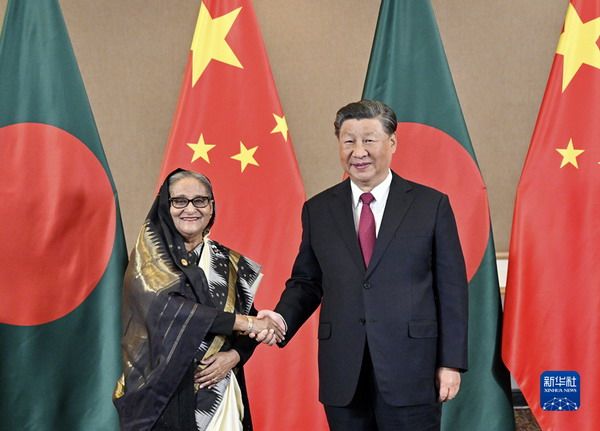By- Amogh Dev Rai (Director Research, ASIA and Editor of De/cypher) and Aurko Chakrabarti (Narrative Designer, ASIA)
China’s ambitious One Belt One Road (OBOR) or Belt and Road Initiative (BRI) to improve connectivity across the Eurasian region has had several geoeconomic and geopolitical ramifications for the Indian subcontinent. Beijing have used the BRI to improve and expand ties with countries across South Asia. The plan highlights China’s efforts to assert their dominance in the global sphere by establishing a trade network that is centred in China. Most countries in South Asia have joined the initiative with the exception of India and Bhutan. New Delhi has been unwavering in its position that it is willing to support collaborative projects across South Asia, but not those that threaten territorial sovereignty. The Sino-Indian strategic rivalry has long taken centre-stage in South Asia and China’s growing presence in the region has led to increased security concerns in India. China has already gained access to important ports around the Indian Ocean, such as Chittagong in Bangladesh, Hambantota in Sri Lanka, and Gwadar in Pakistan, which has caused debate about a so-called “string of pearls” plan intended to encircle India.
Over time, China has established an “all-weather” friendship with Pakistan, which India has reluctantly accepted, but China’s rising investment in Bangladesh, with which India shares its longest border, has caused significant apprehension. Especially after five months of closed-door negotiations have allowed the Chinese Communist Party to take advantage of the Teesta River dredging Memorandum of Understanding to gain a major military upper hand on the Chinese-Indian border near Sikkim. (Intelligence Online)

Bangladesh and China’s economic cooperation has advanced significantly in recent years as Western countries such as the United States and United Kingdom became uncomfortable with allegations of corruption and human rights abuses under the Sheikh Hasina-led Awami League government in 2013. This led to the World Bank pulling out of the construction of the multi-purpose Padma Bridge and China saw this as an opportunity to expand their influence in the region. Since then, Bangladesh has become one of China’s greatest trading partners, and after Pakistan and India, Bangladesh is now China’s third-largest trading partner in South Asia. Bangladesh agreeing to join the BRI initiative in 2016 after Chinese President Xi Jinping’s visit there, only further enhanced ties between the two nations.
Chinese state-owned and private businesses invested close to US$26 billion in Bangladesh between 2016 and 2022 (ORF, 2023). China became the nation’s greatest source of FDI in 2022 as a result of investments that exceeded US$1 billion. According to Bangladesh Bank data, the country’s yearly growth in FDI from China was 13.5%. China’s FDI was only $56 million in 2015, but it has increased 11.5 times in seven years. While, China have invested across different sectors in Bangladesh such as garments, telecommunications and leather manufacturing, their main focus has been on building energy and transport infrastructure. The construction of the Padma Bridge is only one such example as the Chinese also built the Karnaphuli Tunnel, the first under-river traffic tunnel in South Asia. For the 30 million plus people who use the Dhaka-Chittagong-Cox’s Bazar highroads system, the tunnel greatly improves the efficiency of traffic (ORF, 2023). Both China National Offshore Oil Corporation (CNOOC) and China National Petroleum Corporation (CNPC) have made investments in the nation’s energy industry, including oil and gas exploration and production. Bangladesh has received Chinese assistance in the development of various power plants, including the Payra 1320 MW Power Plant and the Patuakali 1320 MW Power Plant, with a renewed emphasis on producing renewable energy sources as China formally decided to stop producing coal-powered plants in September 2021.

Economists believe that trade tensions between the United States and China are forcing Chinese manufacturers to relocate production facilities to other locations, and that Bangladeshi zones will be able to attract those investors. To provide special benefits to Chinese investors, the government is establishing a special economic zone on approximately 783 acres of land in Chattogram’s Anwara upazila.
What worries India is the potential for Bangladesh to fall into a “debt-trap” similarly to the cases of Pakistan with Gwadar Port and Sri Lanka with Hambantota. China has been accused of “predatory-financing” in the past, and faced criticism from Bangladesh’s Finance Minister, Mustafa Kamal, in August 2022, as he appealed to China to address the “debt distress” that they have caused in the developing world. However, Bangladesh has taken a cautious approach to their debt management, allowing themselves ample time to repay loans at a reasonable interest rate, while also controlling their external debt ratio.
India’s frustrations have been growing increasingly since 2018, when, China’s Shanghai and Shenzhen stock exchanges purchased a 25% stake in the Dhaka stock exchange, after India had their bid rejected by the Bangladesh government. To counteract China’s growing presence across Eurasia, India has teamed up with western allies to build their own projects in the Middle East. In May of this year, India’s National Security Advisor Ajit Doval met with counterparts from the United States, Saudi Arabia, and the United Arab Emirates in Saudi Arabia. The purpose of the meeting was to discuss an idea presented by US officials to connect West Asian countries by leveraging Indian expertise in rail connectivity and creating sea lanes connecting the region to South Asia. This project provides India with sustainable and viable options to expand bilateral ties with middle-eastern countries.
With general elections scheduled for early next year in Bangladesh, India and China may find themselves in a precarious situation if the regime changes. If there is a change, China may have to answer to a new administration about a number of stalled projects in the country as according to research from Observer Research Foundation (ORF), 33% of Chinese-backed projects in Bangladesh are currently unviable, and their initial implementation is surrounded by dubious factors (ORF, 2023).








